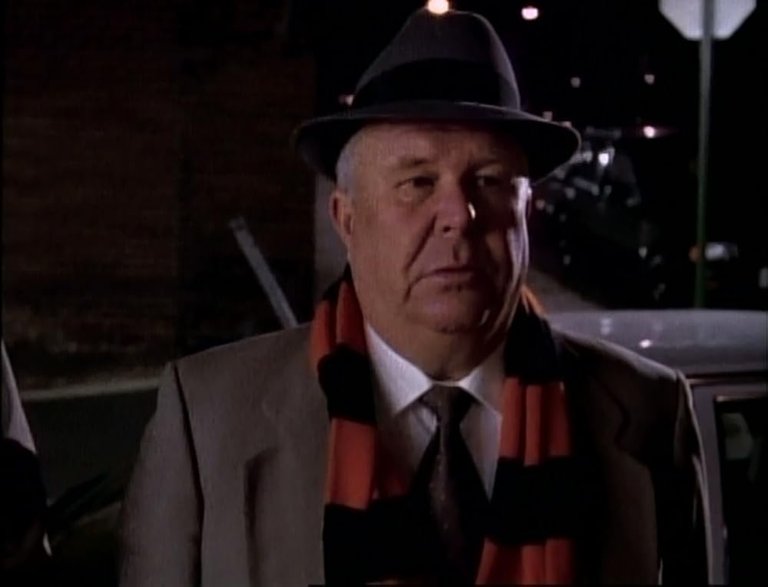
In Search of Crimes Past (S03E17)
Airdate: 14 April 1995
Written by: Jane Smiley
Directed by: Kenneth Fink
Running Time: 48 minutes
Hollywood has never made much effort to conceal its progressive and socially liberal stance on the issue of death penalty, a practice that many screenwriters regard as barbaric and fundamentally at odds with the vision of an enlightened, humane society that America aspires to embody. However, the problem with this perspective is that it is often presented to audiences in a manner that feels preachy, overmelodramatic, and disconnected from the complexities of real life. When a show like Homicide: Life on the Street, which prides itself on gritty realism, attempts to tackle such themes, an episode like In Search of Crimes Past can come across as an aberration.
The central plot of the episode revolves around a case that most fans of the show would classify as a “Red Ball” – a high-priority, emotionally charged investigation. However, unlike typical Red Ball cases, this one was technically solved years earlier. In 1979, Michael Bigelow was convicted and sentenced to death for the murder of Peter Larsen. After spending sixteen years on death row, Bigelow has exhausted all legal avenues to appeal his sentence. Hours before his scheduled execution, his desperate daughter, Lee (played by Felicia Shankman), storms the Baltimore Police Department headquarters and takes Colonel Barnfather hostage. She demands that Detective Stan Bolander, who originally investigated the case, reopen it and find the real killer. Reluctantly, Bolander agrees. Meanwhile, Detective Meldrick Lewis, while investigating the seemingly routine suicide of a man named Jeffrey Swick, discovers a note in which Swick confesses to Larsen’s murder. Bolander, desperate to corroborate this evidence and halt the execution, eventually finds additional proof of Bigelow’s innocence. The hostage situation is resolved, and Bigelow is freed from death row. Despite this outcome, Bolander is left grappling with guilt over his failure to properly investigate the case sixteen years earlier.
A secondary subplot involves the death of Martha O’Donnell, an elderly woman found dead in her bathtub. Initially, her death appears to be natural, though there are subtle suspicions surrounding her husband, Sam (played by Barnard Hughes), with whom she shared fifty years of marriage. Detectives Bayliss and Pembleton, who are assigned to the case, soon uncover the presence of Isabelle Kunkle (played by Helen Stenborg, Hughes’ real-life spouse), Sam’s long-lost love. Isabelle has moved to Baltimore to be near Sam, though she insists she never intended to come between him and his wife. However, a toxicology report reveals that Martha was poisoned with barbiturates, and Sam ultimately confesses to the crime, driven by his enduring passion for Isabelle. This subplot, while somewhat tangential to the main narrative, is elevated by the poignant performances of Hughes and Stenborg, whose chemistry lends emotional depth to an otherwise predictable storyline.
A third subplot focuses on The Waterfront Bar, which has been struggling financially. Detective Munch learns that his business partners have attempted to revive the bar’s fortunes by hiring an experienced Irish bartender named McGonnigal (played by Jerry Stiller). When Munch observes McGonnigal in action, he discovers that the bartender’s penchant for experiments and chaotic methods only exacerbates the bar’s problems. This subplot is intended to provide comic relief, but it falls flat, feeling out of place in an episode that otherwise grapples with weighty themes. The humour feels forced and disconnected from the tone of the series, making it a disappointing addition to the episode.
At the end of the day, In Search of Crimes Past is a relatively weak entry in the Homicide: Life on the Street canon. While the subplot involving Sam and Isabelle is strangely moving, thanks to the stellar performances of Barnard Hughes and Helen Stenborg, it cannot compensate for the episode’s other shortcomings. The bar subplot serves as an ineffective attempt at comic relief, while the central storyline surrounding Michael Bigelow’s wrongful conviction relies heavily on melodramatic coincidences that feel more akin to cheap Hollywood clichés than the show’s usual commitment to realism. The contrived nature of the Bigelow case, in particular, evokes the kind of over-the-top storytelling that Robert Altman famously satirised in The Player.
What makes this episode even more disappointing is the fact that it was written by Jane Smiley, a Pulitzer Prize-winning novelist. Given Smiley’s literary pedigree, one might have expected a script that delves deeper into the moral and emotional complexities of its subject matter. Instead, the episode succumbs to predictable tropes and lacks the subtlety and depth that typically define Homicide: Life on the Street. While it attempts to address important issues such as the death penalty and the enduring consequences of past mistakes, its execution ultimately undermines its potential impact, leaving viewers with a sense of missed opportunity.
RATING: 5/10 (++)
Blog in Croatian https://draxblog.com
Blog in English https://draxreview.wordpress.com/
InLeo blog https://inleo.io/@drax.leo
Hiveonboard: https://hiveonboard.com?ref=drax
Rising Star game: https://www.risingstargame.com?referrer=drax
1Inch: https://1inch.exchange/#/r/0x83823d8CCB74F828148258BB4457642124b1328e
BTC donations: 1EWxiMiP6iiG9rger3NuUSd6HByaxQWafG
ETH donations: 0xB305F144323b99e6f8b1d66f5D7DE78B498C32A7
BCH donations: qpvxw0jax79lhmvlgcldkzpqanf03r9cjv8y6gtmk9